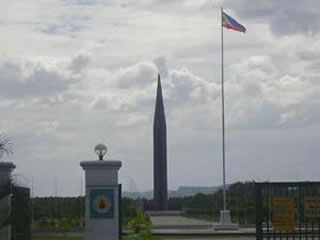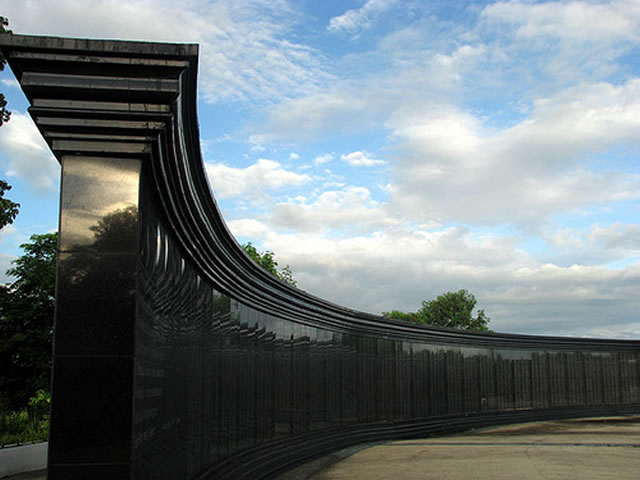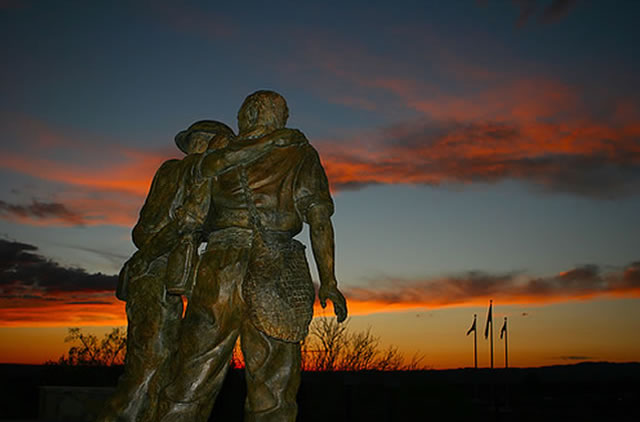 |  |  |
Bataan Perspectives:
Who's Bataan Death March
Remembering and Forgetting the Bataan Death March
in Memorials
Miguel Llora
| Summary Several publicly and privately funded American memorials have been constructed to memorialize and in the process selectively instruct a new generation of Americans about the Bataan Death March. The American legacy is preserved in the Philippines through the Camp O’Donnell Memorial and in the United States through a privately funded Bataan Death March Memorial at Las Cruces, New Mexico. The place where the Bataan Death March ended is a contested site both for the Filipinos and Americans. Set aside by President Corazon Aquino on July 12, 1992, and designated the Capas National Shrine, the park is a total 54 hectares divided between a metaphorical cemetery and a memorial arcade. Similar in design to The National Memorial Cemetery of the Pacific (also known as Punchbowl National Cemetery), the site is divided between cemetery and memorial (Ferguson and Turnbull 119-132), 35 hectares of the Capas National Shrine is planted with trees, each one representing a fallen soldier. |
| Capas National Shrine |
| Figure
1a: Capas National Shrine |
 |  | |
 |  |  |
 |  |  |
| Figure
1b: Capas National Shrine |
 |  |
 |  |  |
| The old Bataan Death March Monument |
| Figure
2 a1: The old Bataan Death March Monument in Capas, in Tarlac as of 2006 |
 |  |  |
| Figure
2 a2: The old Bataan Death March Monument in Capas, in Tarlac as of 2006 |
 |  |  |
| Figure
2 a3: The old Bataan Death March Monument in Capas, in Tarlac as of 2006 |
 |  |  |
| Figure 2 b: The old Bataan Death March Monument in Capas, in Tarlac as of 2007 |

| Camp O’Donnell Memorial Monument |
|
Figure
3 a, b, and c:
Camp O’Donnell Memorial Monument: |

| Camp
O'Donnell Memorial Monument: According to monument’s co-creator Federico "Fred" Baldassarre, pedagogy and remembering were the major impetus of the Battling Bastards of Bataan to build the Camp O'Donnell Memorial Monument. "We participated in the May, 1999 tour of Bataan and Corregidor, and related sites, such as the O'Donnell and Cabanatuan. When we reached Camp O'Donnell, we found nothing there to note that this was the final destination of the Bataan Death March and it was where over 1,600 young Americans died while in the hands of their Japanese captors. Equally disturbing was the ignorance displayed by our tour guides. We felt it would be a complete disgrace if this location, made sacred by the human sacrifice of so many young men, would slowly be reduced to anonymity as the older generation passes on. We felt a very important piece of history would disappear. American Bataan veterans often say, "Hell is a state of mind, but Camp O'Donnell was the place"" (Personal Communication June 21-22, 2008). Government funding for the American Camp O'Donnell Monument was difficult to secure because the story of Bataan is one episode in American history that many are unwilling to admit, implying that the betrayal of American troops by a series of commanders who abandoned both them and the Filipinos eventually landing both in internment camps (Webster 2). The Camp O'Donnell site, by virtue of its focus on American dead downplays participation of the Philippine Scouts and USAFFE. The subsequent unveiling in 2003 of the Capas National Shrine, conversely, places emphasis on the Filipino participation as a response to the Camp O'Donnell Monument. The question of what to do with Filipino World War II veterans continues to haunt the U.S. and Philippines alike. If the U.S. decides to officially acknowledge the joint efforts, it could set a precedent that would lead to monetary as well as immigration status changes for several Filipino veterans. |

| Camp
O’Donnell Memorial Monument: Gordon and Litton also requested financial assistance from the other Bataan related organizations: American Defenders of Bataan and Corregidor, the New Mexico Defenders of Bataan and Corregidor, etc. but were turned down. Why? Only slightly over 3,000 Americans from Bataan came home, and due to the PTSD they all suffered from, due to their time in captivity, most of them decided to keep a very low profile, "fearing they would be labeled as kooks or interned in an asylum." (Baldassarre Personal Communication June 26, 2008). With defeat in the forefront and rescue in the background it is not surprising that American veterans of the Philippine engagements are better respected in the Philippines than in the U.S. In the Philippines, April 9 is a National Holiday, "Araw ng Kagitingan" (The Day of Valor). While in the Philippines, every year on April 9, the Philippine President goes up to Mt. Samat, and gives a speech to the Filipino veterans and foreign dignitaries. |
|
The Bataan Death March Memorial at Las Cruces, New Mexico |
| Figure
4 a, b, c and d: The Bataan Death March Memorial at Las Cruces, New Mexico |
 |
|
|  |
 |
|
|  |
 |
|  |
 |
|  |
 |
|
| Dambana ng Kagitingan or "Shrine of Valor"at Mount Samat |
 |  |  |  |  |
|
| Capas National Shrine Philippines: On YouTube... |